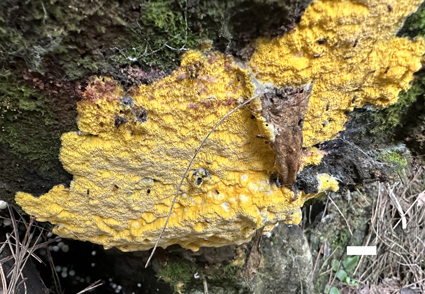Abstract
A new poroid wood-inhabiting fungus in the Polyporales, Luteoporia tenuissima, from southwest China, is described based on morphological and molecular evidence. Luteoporia tenuissima is characterized by annual, resupinate basidiomata with lemon chrome pores when fresh, becoming cinnamon buff when dry, tissues becoming purple in KOH, a monomitic hyphal system, generative hyphae thick-walled and bearing clamp connections, and ellipsoid, smooth basidiospores measuring 2.9–3.8 × 1.9–2.4 µm. The phylogenetic analysis based on ITS + nLSU rDNA sequences shows that the new species belongs to Luteoporia, forming a monophyletic lineage with strong support, clustering with L. albomarginata and L. citriniporia. Both morphological characteristics and molecular phylogeny confirm the placement of the new species within the genus Luteoporia. A full description, illustration, phylogeny of the new species, and comparisons with morphologically similar or phylogenetically related species are provided. In addition, an identification key is provided for the currently known Luteoporia species.
References
- Anonymous. (1969) Flora of British Fungi. Colour identification chart. Her Majesty´s Stationery Office, London.
- Chen, C.C., Chen, C.Y. & Wu, S.H. (2021) Species diversity, taxonomy and multi-gene phylogeny of phlebioid clade (Phanerochaetaceae, Irpicaceae, Meruliaceae) of Polyporales. Fungal Diversity 111: 337–442. https://doi.org/10.1007/s13225-021-00490-w
- Chen, J.J., Cui, B.K., Zhou, L.W., Korhonen, K. & Dai, Y.C. (2015) Phylogeny, divergence time estimation, and biogeography of the genus Heterobasidion (Basidiomycota, Russulales). Fungal Diversity 71: 185–200. https://doi.org/10.1007/s13225-014-0317-2
- Cui, B.K., Li, H.J., Ji, X., Zhou, J.L., Song, J., Si, J., Yang, Z.L. & Dai, Y.C. (2019) Species diversity, taxonomy and phylogeny of Polyporaceae (Basidiomycota) in China. Fungal Diversity 97: 137–392. https://doi.org/10.1007/s13225-019-00427-4
- Dai, Y.C. (2010) Hymenochaetaceae (Basidiomycota) in China. Fungal Diversity 45: 131–343. https://doi.org/10.1007/s13225-010-0066-9
- Felsenstein, J. (1985) Confidence intervals on phylogenetics: an approach using bootstrap. Evolution 39: 783–791. https://doi.org/10.2307/2408678
- Hall, T.A. (1999) Bioedit: A user-friendly biological sequence alignment editor and analysis program for Windows 95/98/NT. Nucleic Acids Symposium Series 41: 95–98.
- Hopple, J.S.Jr. & Vilgalys, R. (1999) Phylogenetic relationships in the mushroom genus Coprinus and dark-spored allies based on sequence data from the nuclear gene coding for the large ribosomal subunit RNA: divergent domains, outgroups, and monophyly. Molecular Phylogenetics and Evolution 13: 1–19. https://doi.org/10.1006/mpev.1999.0634
- Katoh, K. & Toh, H. (2008) Recent developments in the MAFFT multiple sequence alignment program. Briefings in bioinformatics 9: 286–298. https://doi.org/10.1093/bib/bbn013
- Liu, Z.B. & Yuan, Y. (2020) Luteoporia citriniporia sp. nov. (Polyporales, Basidiomycota), evidenced by morphological characters and phylogenetic analysis. Phytotaxa 461 (1): 31–39. https://doi.org/10.11646/phytotaxa.461.1.4
- Maddison, W.P. & Maddison, D.R. (2010) Mesquite: a modular system for evolutionary analysis.
- Miller, M.A., Holder, M.T., Vos, R., Midford, P.E., Liebowitz, T., Chan, L., Hoover, P. & Warnow, T. (2009) The CIPRES Portals. CIPRES. Homepage at: http://www.phylo.org/sub_sections/portal (accessed 4 August 2009) [Archived by WebCite® at: http://www.webcitation.org/5 imQlJeQa)122]
- Nylander, J.A.A. (2004) MrModeltest v2. Program distributed by the author. Evolutionary Biology Centre, Uppsala University.
- Petersen, J.H. (1996) The Danish mycological society´s colour-chart. Foreningen til Svampekundskabens Fremme, Greve. pp 1–6.
- Posada, D. & Crandall, K.A. (1998) Modeltest: testing the model of DNA substitution. Bioinformatics 14: 817–818. https://doi.org/10.1093/bioinformatics/14.9.817
- Rambaut, A. (2012) Molecular evolution, phylogenetics, and epidemiology. FigTree ver. 1.4 Software. Available at: http://tree.bio.ed.ac.uk/software/figtree/ (accessed 20 May 2024)
- Ronquist, F. & Huelsenbeck, J.P. (2003) Mrbayes 3: bayesian phylogenetic inference under mixed models. Bioinformatics 19: 1572–1574. https://doi.org/10.1093/bioinformatics/btg180
- Shen, L.L., Wang, M., Zhou, J.L., Xing, J.H., Cui, B.K. & Dai, Y.C. (2019) Taxonomy and phylogeny of Postia. Multi-gene phylogeny and taxonomy of the brown-rot fungi: Postia and its related genera. Persoonia 42: 101–126. https://doi.org/10.3767/persoonia.2019.42.05
- Song, J., Chen, J.J., Wang, M., Chen, Y.Y. & Cui, B.K. (2016) Phylogeny and biogeography of the remarkable genus Bondarzewia (Basidiomycota, Russulales). Scientific Reports 6: 34568. https://doi.org/10.1038/srep34568
- Swofford, D.L. (2002) PAUP*: Phylogenetic analysis using parsimony (*and other methods). Version 4.0b10. Sinauer Associates, Massachusetts.
- Thiers, B. (2018) Index herbariorum: a global directory of public herbaria and associated staff. New York Botanical Garden's Virtual Herbarium, New York. Available from: http://sweetgum.nybg.org/science/ih/ (accessed 20 May 2024)
- Westphalen, M.C., Rajchenberg, M., Tomšovský, M. & Gugliotta, A.M. (2018) A re-evaluation of neotropical Junghuhnia s.lat. (Polyporales, Basidiomycota) based on morphological and multigene analyses. Persoonia 41: 130–141. https://doi.org/10.3767/persoonia.2018.41.07
- White, T.J., Bruns, T., Lee, S. & Taylor, J. (1990) Amplification and direct sequencing of fungal ribosomal RNA genes for phylogenetics. In: Innis, M.A., Gelfand, D.H., Sninsky, J.J., White, T.J. (Eds.) PCR protocols, a guide to methods and applications. Academic Press, New York. pp 315–322. https://doi.org/10.1038/srep34568
- Wu, F., Yuan, Y., Chen, J.J. & He, S.H. (2016) Luteoporia albomarginata gen. et sp. nov. (Meruliaceae, Basidiomycota) from tropical China. Phytotaxa 263 (1): 37. https://doi.org/10.11646/phytotaxa.263.1.3
- Zhao, C.L., Qu, M.H., Huang, R.X. & Karunarathna, S.C. (2023) Multi-gene phylogeny and taxonomy of the wood-rotting fungal genus Phlebia sensu lato (Polyporales, Basidiomycota). Journal of Fungi 9 (3): 320. https://doi.org/10.3390/jof9030320


